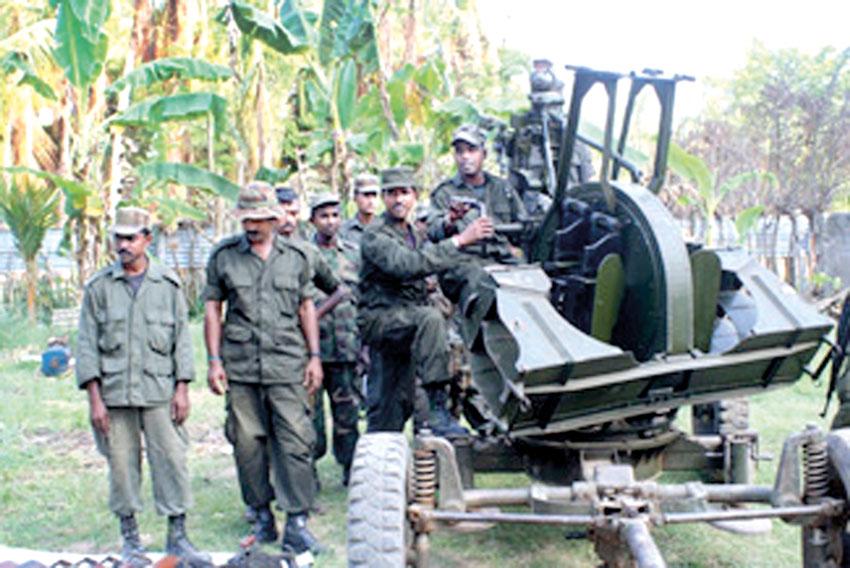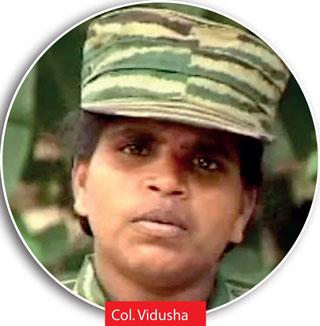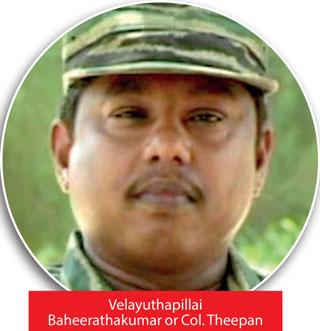11 Mar 2023 - {{hitsCtrl.values.hits}}

Realising that top Tigers were stranded in Ananthapuram and suspecting that Prabhakaran himself may be there the Army moved swiftly and encircled Tiger positions
Most occupants in the three vehicles were killed and the vehicles were virtually reduced to cinders. A few survivors escaped along with the other cadres in the two remaining vehicles of the convoy. Lawrence also returned to safety
There was very heavy fighting in the area of Pachaipullumottai. Tiger resistance was spearheaded by special commander Gopith and commander Amuthaab of the Charles Anthony infantry. On March 31st evening both Gopith and Amuthaab were reported killed
Among other senior Tigers killed were the Special Commander and Commander of the Jeyanthan Infantry Brigade, Manickapodi Maheswaran alias Keerthi and Selvaratnam Sundaram alias Nagesh
By
D.B.S. Jeyaraj
Many battles were fought during the long war between the Sri Lankan armed forces and the Liberation Tigers of Tamil Eelam (LTTE). Among these was the five-day battle fought at Ananthapuram in the Mullaitheevu District from March 31 to April 4, 2009.
The LTTE suffered huge losses with 625 Tigers cadres including many commanders being killed. It was a defining moment in the war as the military debacle at Ananthapuram sealed the fate of the LTTE. Six weeks later the war ended conclusively with the military defeat of the LTTE in the Mullivaaikkaal area.
LTTE Supremo Veluppillai Prabhakaran himself was killed in the Nandhikkadal lagoon area.
The protracted war between the Sri Lankan armed forces and the LTTE began to take a qualitatively different turn from 2007 onwards.
The Tigers, though a guerrilla organisation had been engaging in positional warfare for a long by capturing and retaining territory like a conventional military.
However, the LTTE began losing territory gradually from 2007 with the Sri Lankan Army advancing and the Tigers retreating.
On April 3rd a sizable number of cadres led by Col. Bhanu succeeded in breaking through the military cordon and escaping to safety
The fall of Paranthan in December 2008 was a major turning point. Paranthan’s fall was followed by Kilinochchi and then Elephant Pass in January 2009. Even after losing the Jaffna-Kandy Road or the A-9 highway and all areas to its west, the LTTE was yet confident of withstanding the SL Army for a much longer period in areas east of the A-9 highway.
The final option was to ‘carve’ out an area of about 350-450 sq. km in the Mullaitheevu District with access to the coast and then defend it strenuously.
But the rapid progress of the Army during this phase took the LTTE by surprise. Within a relatively quick period, the various military divisions and task forces had made sweeping strides into Tiger territory.
As a result, the LTTE and hundreds of thousands of civilians were boxed into a small space that kept on shrinking as the Army began advancing.
The military juggernaut rolled forward relentlessly and the Tigers and Tamil civilians were confined to a small littoral strip of territory located between the A-35 highway (Paranthan-Mullaitheevu road) and the Nanthikadal and Chalai lagoons on one side and the Indian Ocean on the other. Soldiers from five divisions and three Special Forces besieged the LTTE. The Tigers tried desperately to break out of this encirclement and drive the forces back.
The LTTE registered a minor success in late February 2009 when it launched a counter-strike led by senior commanders Sornam and Lawrence.
The LTTE pushed SLA soldiers back by about 600-700 metres from their forward defence line positions and then proceeded to the north for about eight km.
Puthukudiyiruppu AGA Division
The SLA soldiers however rallied and fought back in early March. They compelled the Tigers to retreat and regained their original positions in the Puthukudiyiruppu AGA Division of the Mullaitheevu District.
Thereafter it was a stand-off with the LTTE being in defence mode.
It was in this situation that the LTTE planned to launch a massive counter-offensive against the armed forces. The idea was to conduct a meticulously planned multi-pronged operation that would deliver a crippling blow to the security forces.
Several top Tiger leaders including its northern military commander Veluppillai Baheerathakumar alias Theepan were holed up in Ananthapuram busily planning a major counter-attack on the armed forces.
Ananthapuram is situated along the Puthukudiyiruppu -Iranappaalai-Puthumaathalan roads The road to Iranappaalai proceeds eastwards from the Puthukudiyiruppu junction on the A-35 highway. Another road starts from Iranappaalai east to Puthu (New) maathalan along the coast.
There is another minor junction on this road at Pachaipullumottai from where a small road goes to Palam (Old) Maathalan.
Ananthapuram and Iranappaalai are part of the Puthukudiyiruppu AGA Division, Other areas belong to the Karaithuraipatru AGA division.
Around 1000 Tiger cadres converged at Ananthapuram to prepare and launch a counterattack. LTTE leader Prabhakaran also visited the place. The defences in and around the Puthukudiyiruppu - Iranaippaalai Puthumaathalan Road was in the hands of the Charles Anthony infantry brigade.
Unmanned Aerial Vehicles
What happened however, was that Unmanned Aerial Vehicles (UAV) or drones used by the Armed forces detected a lot of movement in the Ananthapuram area.
Anticipating a counter-offensive, the Army jumped the gun with a pre-emptive operation.
The 58th Division Commanded by Brig. Shavendra Silva, 53rd Division led by Gen. Kamal Gunaratne and Task Force Eight led by Col. GV Ravipriya mounted a multi-pronged military operation on the night of March 30th 2009.
The 58th Division proceeding south by south-east from northern Puthukudiyiruppu and the 53 & TF Eight proceeding north by north-east from Southern Puthukudiyiruppu advanced rapidly and linked up at the Pachaipullumottai Junction along the Puthukudiyiruppu road behind LTTE positions.
The Tigers were taken by surprise.
Pachaipullumottai
There was very heavy fighting in the area of Pachaipullumottai. Tiger resistance was spearheaded by special commander Gopith and commander Amuthaab of the Charles Anthony infantry. On March 31st evening both Gopith and Amuthaab were reported killed.
This proved to be a major loss to the LTTE.
The deaths of Gopith and Amuthaab had a demoralising effect on cadres.
This loss of morale is attributed to the cause of weakened Tiger defences which in turn led to rapid breaching, linking and encircling by the armed forces.
‘Marooned’ on Land
The LTTE cadres in Ananthapuram, who were engaged in preparing for the major assault, were suddenly and unexpectedly ‘marooned’ on land.
Realising that top Tigers were stranded in Ananthapuram and suspecting that Prabhakaran himself may be there the Army moved swiftly and encircled Tiger positions.
A siege was in progress. Prabhakaran was not there as he had left the place on March 26th. But the other important Tigers including Theepan were still there.
The 4th, 6th,8th, 12th,14th and 20th Gajaba Battalions, 5th Vijayabahu,9th Gemunu Watch, 11th and 20th SL Light Infantry along with 1 Special Force, and two commando units got into action.
A footpath from Ambalavanpokkanai to Pachaipullumottai used as an emergency supply route by the LTTE was also interdicted.
Thus more than a thousand Tiger cadres and commanders were trapped and encircled in a two sq km area consisting mainly of coconut plantations, and palmyrah groves.
In a desperate bid to break the siege Sea Tiger Special Commander Soosai sent a contingent of 80 tigers in 15 boats by sea to aid his beleaguered comrades at arms.
These boats began sailing from Valainjarmadam and hoped to beach near Pattiaddy and fight their way through. This did not materialise as the Navy maintaining strict vigil engaged the flotilla and beat back the Sea Tigers, thus preventing the boats from landing.
The Tigers also sent 120 cadres as reinforcements under Lawrence, who was already injured. The Army using lethal devices scorched and destroyed two buses and a truck.
Most occupants in the three vehicles were killed and the vehicles were virtually reduced to cinders. A few survivors escaped along with the other cadres in the two remaining vehicles of the convoy. Lawrence also returned to safety.
Eventually, on April 3rd a sizable number of cadres led by Col. Bhanu succeeded in breaking through the military cordon and escaping to safety.
Bhanu himself was injured in the process. About 45 to 50 Tiger cadres blew themselves up to create the gaps through which Bhanu and others escaped.
Col. Theepan
Col. Theepan, Deputy Military Chief of the LTTE as well as its Northern Commander had an opportunity to escape along with Bhanu.
Theepan was injured twice on both April 1st and 2nd. Bhanu wanted to carry Theepan along with him. But Theepan refused.
He said that he won’t desert or abandon his fighter cadres and seek safety.
“If I come out I’ll come with the cadres. Otherwise, I’ll die with them,” he reportedly told Bhanu and later informed Intelligence Chief Pottu Ammaan via radio.
The military intercepting this communication was amazed at Theepan’s sense of loyalty to his cadres and his readiness to die willingly.
Subsequently, Theepan’s conduct came in for praise among several officers from the Army’s upper echelons.
Another intercept was an exchange between Intelligence Chief Pottu Amman and woman Tiger leader Vidusha.
She was heard pleading for reinforcements and supplies urgently.
Pottu was virtually choked up with emotion saying all his efforts had failed and that they could not penetrate the blockade.
The writing was on the wall for the besieged Tigers.
Despite his commitment to his cadres, the rest of the Tigers under the overall command of Theepan were not lucky as those, who escaped with Bhanu. Despite the dangerous situation the Tigers led by Theepan continued to withstand the three-day siege. The Tigers were deprived of food, water and medical supplies. Nevertheless, the beleaguered tigers kept resisting.
Appeals were made in Tamil through amplifiers to the Tigers to surrender but the majority of the Tigers refused to heed the call to surrender.
116 tigers surrendered to the Sri Lankan Army in small groups at various times.
But the others fought on against overwhelming odds preferring to die fighting than surrender.
In a desperate bid to break the siege Sea Tiger Special Commander Soosai sent a contingent of 80 tigers in 15 boats by sea to aid his beleaguered comrades at arms
Bombing and shelling
From April 3rd night, the nature of combat changed.
Massive aerial bombardment and strafing through planes and helicopters were on. Continuous artillery shelling was also done.
Thousands of shells were fired throughout April 4th. It was all over on Sunday, April 5th and the soldiers began gradually recovering LTTE bodies and identifying them.
By Monday around 525 bodies had been recovered and around 60 identified.
Many Tigers had died biting the cyanide capsule and swallowing its contents.
By Tuesday a further 100 bodies were recovered.
About 60 of these were recovered in a bloated condition lying in a field. Another 40 were in charred condition inside two small buildings where the cadres had sought cover.
At least 18-20 injured cadres were captured alive. Some of these were top-rung Tigers. Three girls were captured hiding in a makeshift pit, covered by leaves.
Hasty cremation
The Army released some pictures of the dead Tigers including Theepan and Vidusha.
Some pictures of dead tigers laid out in rows were also released. The bodies of the dead Tiger cadres, shown in the pictures, were in abysmal condition. The deteriorating condition of the recovered bodies resulted in hasty cremation.e
The death of its northern Military Commander Theepan was the single biggest loss to the LTTE in the Ananthapuram battle.
The veteran Tiger was posthumously promoted to Brigadier. Along with Theepan, the top four woman fighter Commanders were also killed. They were Vidhusha, Special Commander of Maalathy Regiment, her deputy and Maalathy regimental commander Kamalini, Durga, Special Commander of Sothia Regiment and her deputy cum Commander Mohanaa.
Among other senior Tigers killed were the Special Commander and Commander of the Jeyanthan Infantry Brigade, Manickapodi Maheswaran alias Keerthi and Selvaratnam Sundaram alias Nagesh.
The Jeyanthan Brigade is raised from Eastern Province cadres.
Another huge loss was that of Gaddafi also known as Viduthalai and Amuthan. Gaddafi was a specialist in firing anti-aircraft missiles. He has brought down several aircraft of the Sri Lankan Air Force through his shoulder-fired missiles.
The LTTE’s elite Special Forces Division is named after former Tiger leader Radha.
This Special Force was led by Silambarasan. He was killed.
The Deputy-Commander of the Radha Regiment was Anbu. He was seriously injured and captured alive. Likewise, Asmi, the leader of the Ponnammanân Mines Unit was also seriously injured and captured alive.
The leader of the Kittu Artillery Unit, Manivannan and the Chief of Kutty Sri Mortar Unit Gopal were killed. Seralaathan, who was in charge of the Tiger TV Nitharsanam was also killed. Among other senior Tigers killed who have been identified are Ruban, Panjan, Nehru, Anton, Maankuyil, Amudha, Iniyawan, Aadithyan and Chitrangan.
A senior sea Tiger Mahindan was also killed.
Multi-Barrel pedal gun
The Ananthapuram debacle also resulted in the LTTE losing many weapons including three 130 mm artillery, one 85 mm pounder, five 81 mm mortars, and four 12. 7mm anti-aircraft guns and a multi-barrel 30 mm pedal gun.
Four 30 mm barrels were fixed on this and they could be fired simultaneously like a multi-barrel rocket launcher. It could be fired by stepping on a pedal. This piece of equipment proved very lethal in previous rounds of fighting as it can be used both as artillery and an anti-aircraft gun.
In what was a rare, commendable gesture, a Defence Ministry media release praised the LTTE fighters who had died in combat as dedicated but misguided.
D.B.S. Jeyaraj can be reached at [email protected]
25 Dec 2024 9 hours ago
25 Dec 2024 25 Dec 2024
25 Dec 2024 25 Dec 2024